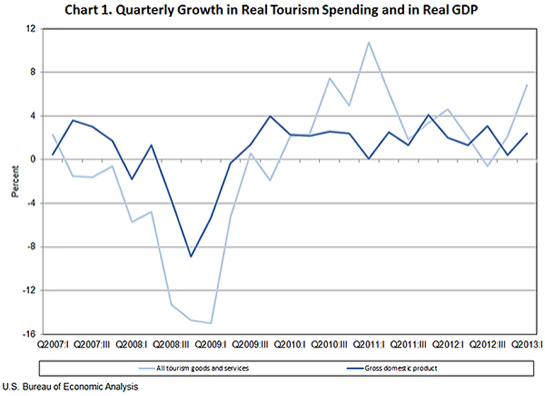U.S. Tourism Industry Spending Outpacing National GDP Growth: US Bureau of Economic Analysis (BEA)

Travel and tourism in the U.S. is flourishing compared to the overall national economy, according to quarterly statistics released by the U.S. Bureau of Economic Analysis (BEA) on Monday.
Spending on U.S. travel and tourism rose by 6.8 percent in the first three months of 2013, compared to national gross domestic product growth of 2.4 percent in the same quarter.
Growth in tourism spending has mostly stayed higher than GDP growth since about mid-2010, according to bureau data. In early 2011, tourism spending rose by about 10 percent, while GDP growth stayed at 2 percent or lower.
This latest boost was caused primarily by more air traffic, for both domestic and international flights, and by more car rentals. It’s the best tourism growth in the last seven quarters.
This quarterly spike is certainly noteworthy, said PricewaterhouseCoopers LLP (PwC) travel and tourism analyst Scott Berman, in a phone interview with IBTimes.
“Generally, consumers are feeling better, both corporate citizens and leisure travelers,” said Berman. “And not only within the U.S. – the U.S. is benefiting from a convergence of travel from, really, all over the world.”
Although tourism fell hard during the recession, it rebounded as well as any other sector, said Berman, with demand for hotels specifically now surpassing 2007 and 2008 levels. He doesn’t see any obvious imminent obstacles that will impact U.S. tourism in the coming months.
Employment in travel and tourism also rose by 2.3 percent in the latest quarter, compared to overall U.S. employment rising by 1.9 percent. The growth in employment was helped by hiring boosts in the hospitality sector and food and drink outlets.
The sector employed 7.9 million people in early 2013.
According to BEA data, total output from the tourism industry has risen steadily from $1.2 trillion in 2010 to $1.45 trillion in 2012, after performing badly in 2008 and 2009.
© Copyright IBTimes 2025. All rights reserved.






















